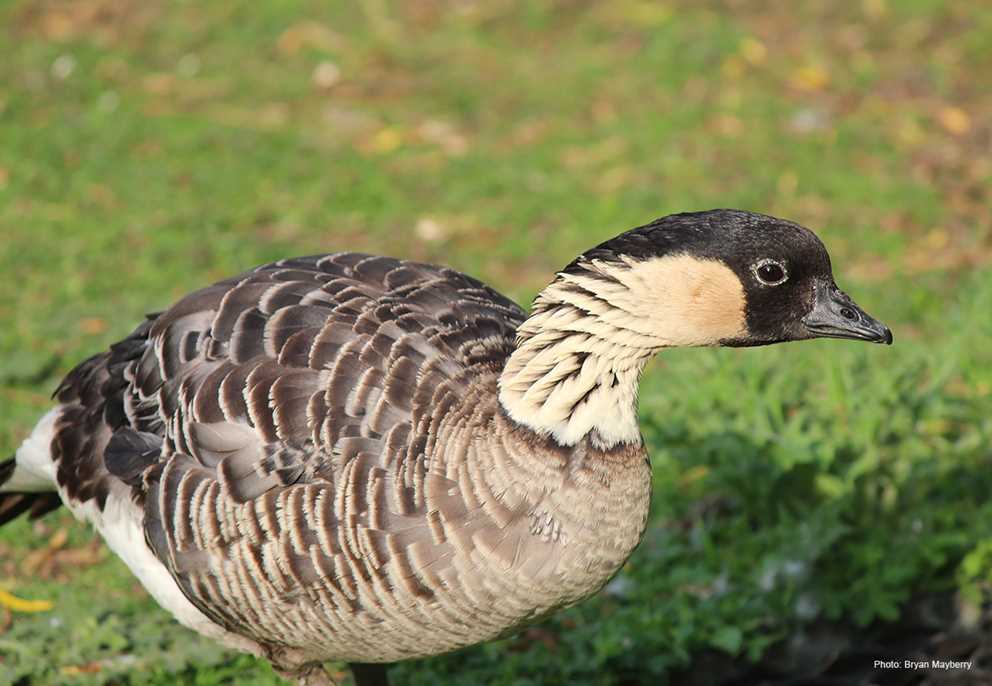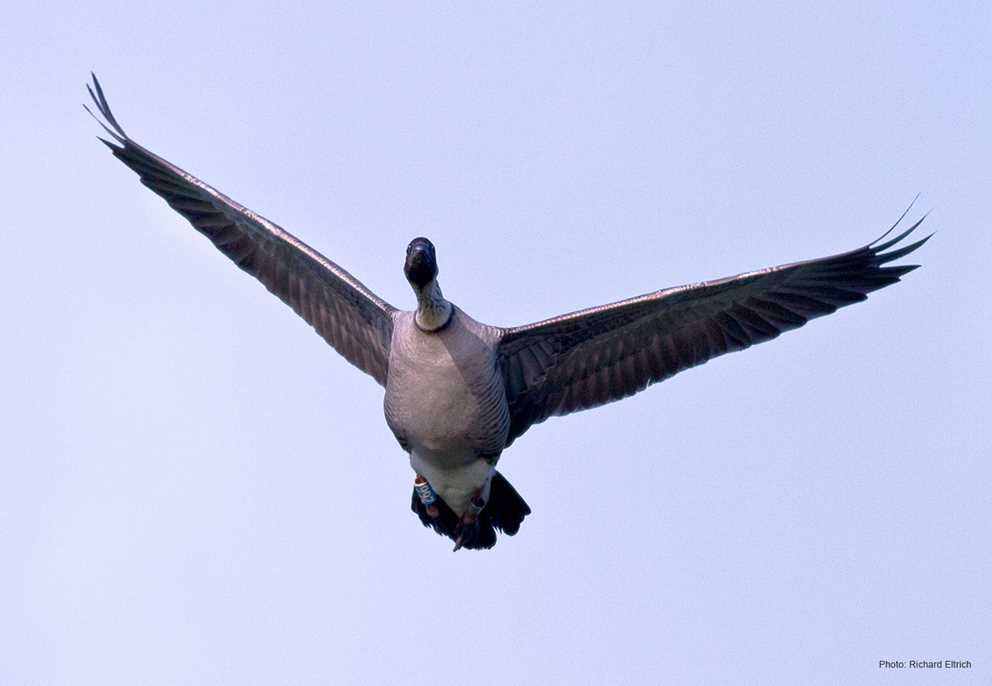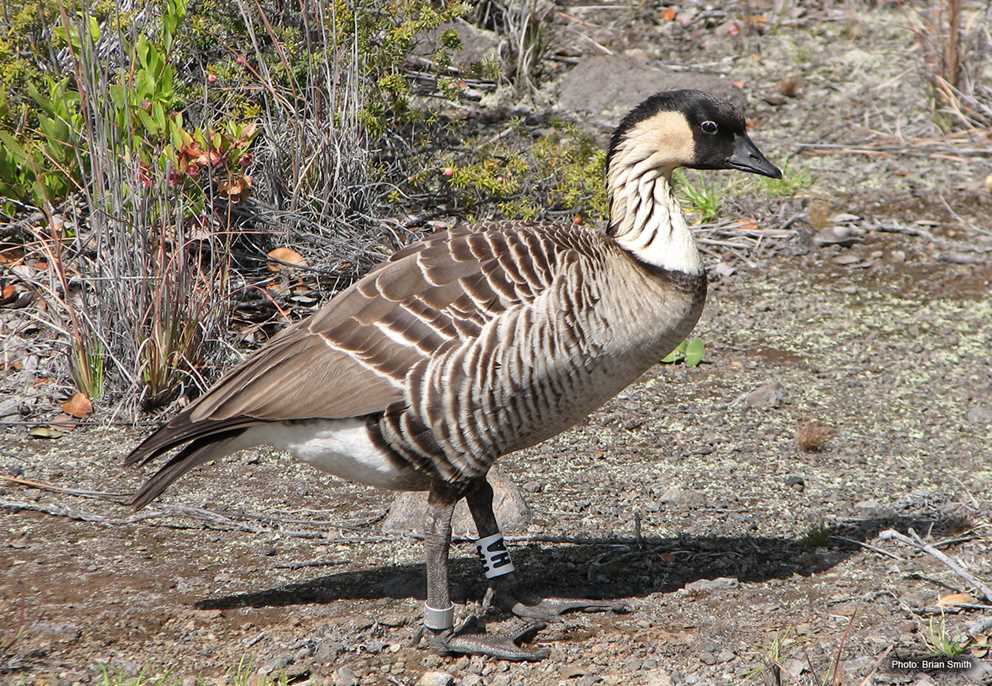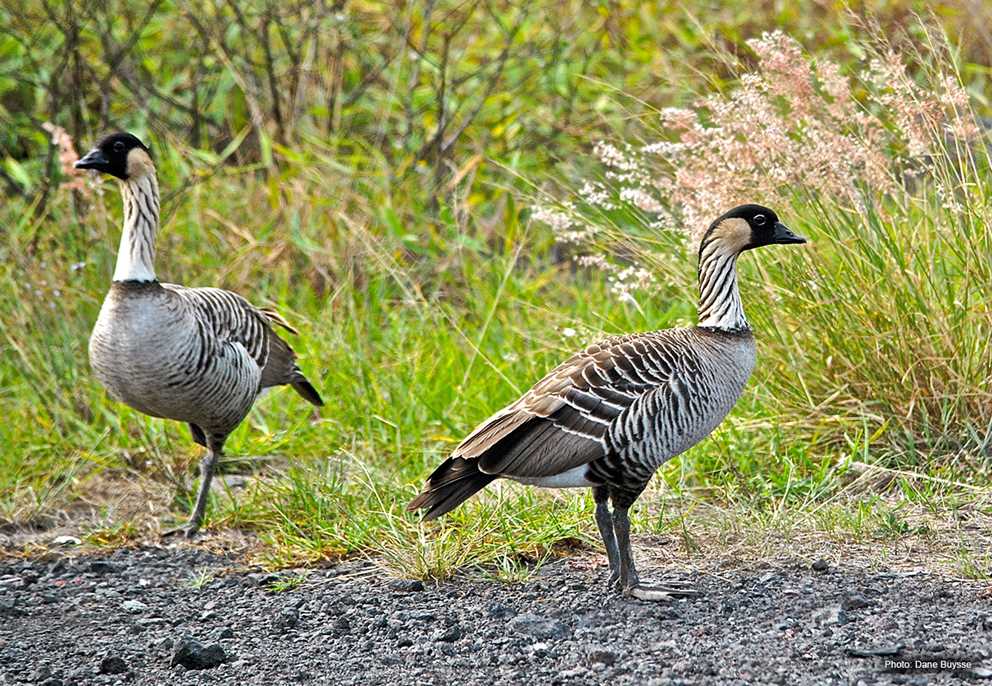Overview
The Hawaiian Goose, better known by its Hawaiian name of Nënë, is among the most range-isolated, sedentary, and threatened species of waterfowl in the world. Historically they ranged throughout the Hawaiian Islands, but today their range is restricted to Kauai, Hawaii, and Maui. They are highly terrestrial, using grassy shrublands and sparsely vegetated lava fields, though they may now also be found in other habitats. They are medium-sized geese. The face and crown are black with a cream cheek patch, the neck is heavily furrowed, gray streaked with black, with the rest of the plumage sepia with substantial barring, and white upper and under tail coverts. They have several adaptations for use of terrestrial habitats, including more upright, erect posture, longer legs, and reduced webbing on the feet.
Description
Key Identification Features
- Hawaiian Geese are medium sized among geese species.
- The sexes are similar. The face and crown are black with a cream cheek patch, the neck is heavily furrowed, gray streaked with black, with the rest of the plumage sepia with substantial light tan barring, and white upper and under tail coverts. The bill is short, stubby, and black, and the legs and feet are black.
- They have several adaptations for use of terrestrial habitats, including a more upright, erect posture, longer legs, and reduced webbing on the feet.
Male/Female Average Length and Weight
- Mass: Males 3.7–6.7 lbs.; Females 2.9–5.6 lbs.
- Wing Length: Males 15.0–15.2 in.; Females 13.8–14.8 in.
Identification
- Alternate (Breeding) and Basic Plumage: Both plumages are similar, and similar between sexes. The face and crown are black with a cream cheek patch, the neck is heavily furrowed, gray neck streaked with black, with the rest of the plumage sepia with substantial light tan barring, and white upper and under tail coverts. The bill is short, stubby, and black, and the legs and feet are black.
In-flight Identification
- A medium-sized goose, with a dark face and crown, lighter cheek and neck, and the body is sepia with lighter barring throughout. The vent and rump are white.
Vocalizations
- Their call is like Canada Geese but quieter.
Similar Species
- Unmistakable, native to Hawaii where other species of geese are rare in winter. Canada Geese have a black head and neck with a white cheek and chin that is distinctive.
Habitat Preferences
- Probably nested in leeward lowlands after winter rains stimulated fresh growth of vegetation. Today most use managed grassy areas below 1,000 feet of elevation year-round, and they are frequently seen on golf courses and other urban grassy areas.
Foraging Habits and Diet
- Hawaiian Geese graze and browse a variety of leaves, seeds, fruits of grasses, herbs, and shrubs year-round.
Breeding Habits
- Monogamy: Hawaiian Geese are monogamous with lifelong pair bonds.
- Nest Locations: The nest is on the ground usually under shrubs or trees.
- Clutch Size: Averages 3 eggs. The eggs are white, sub-elliptical to long sub-elliptical, and are 2.7 by 1.9 in. The incubation period is around 29 to 32 days and is performed by females only.
Migration & Distribution
They are sedentary with a range currently restricted to Kauai, Maui, and Hawaii.

Conservation Status
- IUCN Status: Near Threatened
- Population Status: As of 2022, there were 3,862 Hawaiian Geese, of which 2,430 occur on Kauai. The species was downlisted from Endangered to Threatened in 2020. Populations are maintained in part by releases of additional birds. The species is the sixth most endangered species of waterfowl in the world.
- Conservation Concerns: Loss and degradation of native habitat, and adaptation to more urban habitats like golf courses, lead to disturbance and conflict with humans. On some islands exotic mongoose predation is high.
- Conservation Focus: Conservation efforts focus on protecting and restoring habitat and minimizing impacts of development and human interactions.
Harvest Information
- Historically eggs, young and adults were taken for food by Indigenous peoples, and later others that arrived on the Hawaiian Islands. Today there is no harvest as efforts continue to restore the species and remove it from threatened/endangered status.




